Society Research
Carbon dioxide removal policy in the making: Assessing developments in 9 OECD casesCSS member Felix Schenuit et al. publish a new research paper in "Frontiers in Climate"
4 March 2021, by CSS

Photo: private
CSS member Felix Schenuit has recently published a new paper in "Frontiers in Climate" together with an international and interdisciplinary team of co-authors: Rebecca Colvin, Mathias Fridahl, Barry McMullin, Andy Reisinger, Daniel Sanchez, Stephen M Smith, Asbjørn Torvanger, Anita Wreford and Oliver Geden.
Key messages
- Net zero Greenhouse gas (GHG) emission targets have emerged as a new organizing principle of climate policy.
- In this context, carbon dioxide removal (CDR) is rising on the political agenda of governments,
policymakers and stakeholders – CDR policies are already in place or currently emerging.
Assessing these developments is a relevant part of exploring future feasibility of CDR. - The study systematically assesses current developments in CDR policymaking by analysing 9 OECD
empirical case studies: the European Union, Ireland, Germany, Sweden, Norway, the United
Kingdom, Australia, New Zealand, and the United States. - Countries’ approach toward CDR differ across 5 key dimensions:
- Accounting of CDR in mitigation targets
- View by actors of incumbent regime
- Methods addressed (ecosystem- / geochemical-based)
- Relation of CDR policy instruments to broader climate policy-mix
- Government support for CDR niches.
- The authors observe "varieties of CDR policymaking" and propose a tripartite conceptual typology that differentiates between 1) incremental modification, 2) early integration & fungibility, and 3) proactive CDR policy entrepreneurship.
- Future comparative work is needed to assess developments in different sets of countries as well
as ongoing dynamics in the countries examined in this study.
This summary can also be found here or here as a thread on Twitter.
Read the full article here (doi: 10.3389/fclim.2021.638805).


